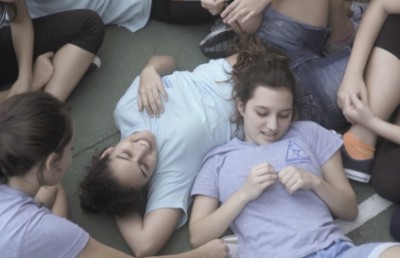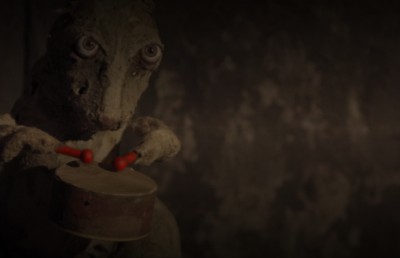Cult Movie Extraordinaire: David Lynch’s Eraserhead
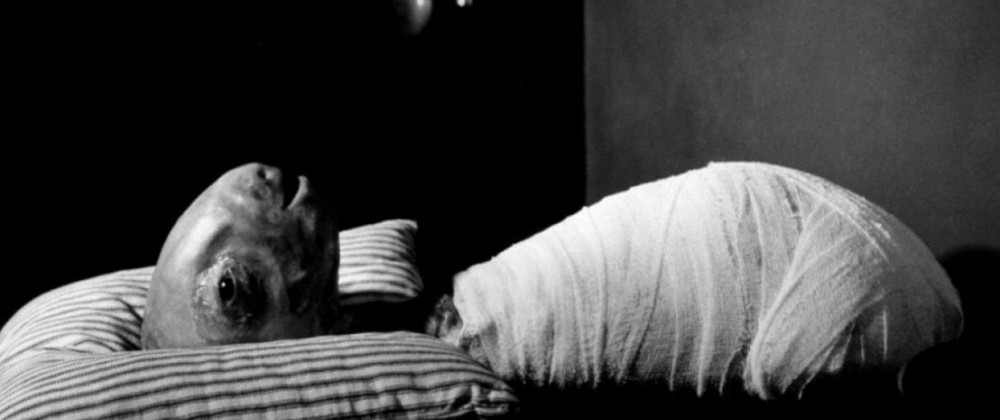
Eraserhead (Photo source, Criterion)
The phrase used to announce Eraserhead‘s (1976) birth when it was unleashed on the world was: A dream of dark and troubling things. This tagline certainly acknowledges the bizarre world the film’s characters inhabit, but it’s significant to note that it also shies away from labeling that world a nightmare. This is not to say that Eraserhead can’t be regarded as a horror film. In fact, David Lynch created an ominous and oppressive environment that satisfies genre expectations in numerous ways. Over the course of Eraserhead’s eighty-nine minutes the spectator is subjected to a series of twisted and bizarre images. There are people with strange facial growths, miniature chickens that churn out viscous fluids while their legs twitch on the dinner plate, decapitation, and a horribly deformed baby.
There is, however, one rather glaring omission that separates Eraserhead from the vast majority of horror films: no one ever screams. The baby may whine, characters may get angry or frustrated and lash out, but the noticeable absence of a moment of pure terror means that the film never fully opens the throttle on horror. If we imagine David Lynch behind the scenes, pulling levers like the man in the planet, then it’s relatively easy to see that he has the switches marked ‘dread’ and ‘frustration’ at their maximum, but isn’t as interested in the direct application of terror. As a consequence of this, the atmosphere in the theatre grows as claustrophobic as the confines of Henry’s apartment. Rather than casually viewing and reacting to the onscreen events, we find ourselves drawn into the environment and trapped there. Any terror that we, as spectators, may experience is simply in relation to the suffocating levels of these other feelings.
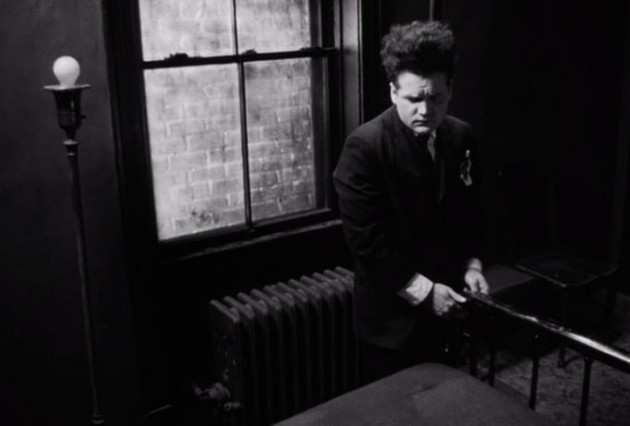
Eraserhead (Photo source, Criterion)
In nearly every horror film ever made there is a moment where the characters express some degree of terror. A shocked look of horror, a stifled shout, or a bloodcurdling scream, these are all cues for the audience to let out some of the tension. To scream in unison, and follow that up with a deep, calming breath. In Eraserhead’s decidedly disturbing world that moment of release never arrives. There is no shock cut that provides the audience with their cue to respond. Consequently, the spectator’s feeling of anxiety is kept corked up inside them. Lynch seems to recognize that the most terrible dreams of all are the ones where we suddenly wake up feeling paralyzed. Unable to cry out, unable to even breathe, we wait for the abject terror to abate before we can start feeling normal again. This is the territory that Eraserhead ventures into, and Lynch’s approach is that the viewer should be given as little respite as the denizens of the bleak, urban Hell he has concocted.
If the startling moment of release that punctuates standard horror films provides a brief opportunity for spectators to savor an almost post-coital feeling of pleasure, then Lynch’s unorthodox strategy of withholding that pleasure must also serve some purpose. The most noticeable effect of this is that it builds a strange tension that is removed from any palpable type of suspense. Henry never really seems to be in any danger. He never really shows signs of any sort of expression beyond a perpetual mask of mild anxiety and worry. We are witnessing his dream, and while Henry may not like the rules that govern it, at least he appears to have a rudimentary idea of what to expect. The audience, on the other hand, is thrust into a world that is far removed from any familiar comfort zone. While conventional horror films attack the psyche by virtue of their graphic assaults on the human body, Eraserhead bypasses the flesh and goes straight for the brain. If Tobe Hooper’s The Texas Chain Saw Massacre (1974) begged the question “who will survive, and what will be left of them?” then Eraserhead demands to know what will be left of their sanity.
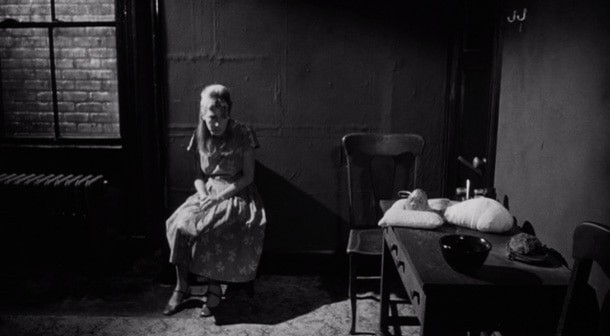
Eraserhead (Photo source, Criterion)
One of Eraserhead’s most memorable moments is the quirky dance number performed by the Lady In The Radiator (Laurel Neer), which shows that the strange, industrial world that Henry inhabits is not completely devoid of any sort of levity. This strange dose of respite comes at a time when Henry is feeling particularly tormented and alone. Mary has gone home to stay with her parents, and the baby has fallen sick. Henry crawls into bed, but is troubled by the suffering of the baby, which has broken out in a painful looking rash. Unable to shake the vision from his head, he is far too tense to slip into the solace of sleep. With his brow furrowed with worry, and his eyes wide open, his gaze falls upon the radiator, which is suddenly lit up from within. We cut back to Henry, now looking curious, rather than troubled, and then back to a much closer view of the radiator. The camera twists to a better vantage point, and then a jump cut takes us through the device and into the space behind it. The wall parts like a theatre curtain and a stage slips into view. The camera glides along the front edge of the stage, and light bulbs, which are resting on a bed of hay and don’t appear to have any source of power, flicker into life one by one. A Fats Waller organ number fades up in the sound mix as the camera reveals more of the space. The floor of the stage itself features a black and white checkerboard pattern, and at the far right, beside a black column, are the white pump clad feet of the woman who inhabits this strange performance space. The camera slowly tilts up, while pulling back and to the left, as the Lady begins to dance her way to the middle of the stage. When the whole space can be seen, with curtains framing the edges and the Lady in the centre, Lynch cuts to a close up her face. Her eyes twinkle with delight, and a mischievous grin spreads between her grossly disfigured cheeks. Platinum blonde hair, pale skin and a white dress impart her with a strangely angelic quality. She moves back and forth across the stage with precocious glee, but the real world soon invades this fantastic vision. Spermatozoic creatures begin dropping from the ceiling, and the Lady begins punctuating pauses in her musical accompaniment by stomping on these unwelcome intrusions; sending them out of existence and into oblivion. Suddenly there is a gust of wind, the lights dim and she backs away into the void of darkness. (49:00-52:15)
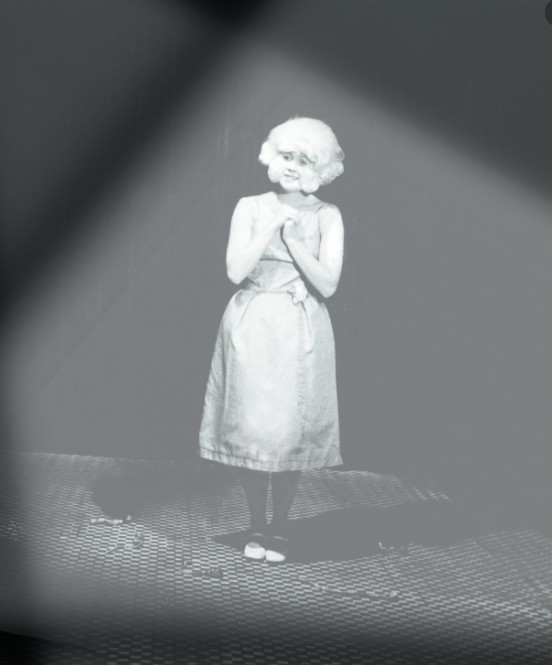
Eraserhead (Photo source, Criterion)
From the comfortable distance of more than forty years it’s easy to spot some of the aberrant obsessions in this sequence that have come to be labeled as endearingly Lynchian; meticulous sound design, geometric floor patterns, fascinating physical deformity, and the tangible spaces of imagined worlds. The stage seems to belong to the same dimension as The Black Lodge that sits at the heart of Twin Peaks (1990) paranormal universe; and when the angelic Lady In The Radiator performs a song later in the film, the captivating musical number can now be seen as an obvious precursor to Dorothy’s torch song serenades in Blue Velvet (1986), as well as Julee Cruise’s numerous appearances in Twin Peaks. Spectators who are familiar with Lynch’s career may recognize a number of other images in the film that manifest themselves throughout his later career, but at the time of its release audiences lacked this perspective. Everything must have seemed uncomfortably bizarre, and in Weirdsville USA, Jack Nance recounts the violent reaction the film received from a potential producer: “He was enraged; he was offended. He went storming out of the screening room, and he was yelling, ‘People don’t talk like that! People don’t act like that! You people are crazy! What do you think you’re doing?’” (Paul Woods, p. 28).
The initial review in Variety echoed this sentiment to such an extent that Nicholas Rombes compares it to the way popular media responded to the confrontational punk rock of the period (Nicholas Rombes, p. 63), while Hoberman and Rosenbaum suggest that the writer’s “responses were in a way as violent as the film itself” (Jim Hoberman and Jonathan Rosenbaum, p. 215). Hoberman himself wrote that Eraserhead was “looking for a cult” (Jim Hoberman, p. 107) in the review he penned for the Village Voice. Even Ben Barenholtz, owner of New York’s Elgin Theatre, and one of the early champions of the film, considered it to be a film that world wasn’t quite ready for. Eraserhead, to many, was a few years ahead of its time (Jim Hoberman and Jonathan Rosenbaum, p. 216-219).
Stanley Kubrick was one artist who recognized the originality of the work, openly proclaiming it to be his favorite film (David Lynch, ed. Chris Rodley, p. 77) during the period when he was at work on his Stephen King adaptation The Shining (1980). While Kubrick never discussed whether Eraserhead had any influence on the direction he took with that project, The Shining has more in common with the pervasive sense of confinement and dread of Lynch’s film than it does with the more explicit and exploitive horror films of the same period.
The 1970s had, after all, yielded a number of seminal horror films. Two of the most prominent examples are The Exorcist (1973) and The Texas Chain Saw Massacre (1974). Eraserhead, which began shooting in May of 1972, was already in production when these two films were released. It features elements which are not so terribly far removed from scenes in both movies, however it treats them in such a vastly different way that it simply doesn’t seem to belong to the same universe, let alone the same filmic genre. Take for example the run-up to the dinner sequence, which finds Mary’s paralyzed grandmother, sitting in the kitchen smoking cigarettes. Mary’s mother places a salad bowl in the old woman’s lap, and then proceeds to manipulate the ancient lady’s arms so that she may contribute to the family’s supper by tossing the salad. The episode plays out like an otherworldly parody of the decrepit grandfather dropping the mallet in his attempt to help put meat on the table in The Texas Chain Saw Massacre.
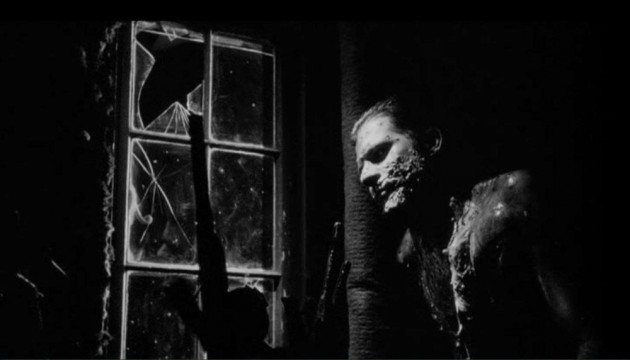
Eraserhead (Photo source, Criterion)
There is also an unsettling kinsmanship between the tortured, demon-possessed girl in The Exorcist and the sickly, mutant baby of Eraserhead. The two children spit out thick substances, suffer intensely and mockingly laugh at the misfortune of others. In The Exorcist, medical science invades the body looking for a physical cure to a spiritual ailment, while in Eraserhead, Henry takes matters into his own hands; cutting open the bandages that wrap the baby and discovering a cryptic mass of disembodied organs. Although Henry appears to be angry when he fetches the scissors from the drawer, he doesn’t kill the baby out of malice, he kills it via discovery. He sits down on a chair near the table that the baby lays on, and after a moment of uneasy contemplation. He calmly cuts open the gauze that conceals the infant’s torso. The baby begins to convulse, and the bandages slowly come apart. Henry looks inside with a mixture of revulsion, concern and perverse curiosity. The innards, freed from their mummy-like restraints, begin to expand. Henry tentatively pokes at the exposed viscera, and then violently uses the scissors to stab at them when it becomes apparent that he has gone beyond the point of no return. Recoiling in disgust, and shame, Henry cowers on the far side of the room and envisions the baby undergoing an apocalyptic metamorphosis into a gigantic creature of pure energy. The electric outlets shower sparks, the lamp against the wall flashes on and off with a stroboscopic intensity, and Henry absorbs it all with a look of overwhelmed incomprehension. The bulb in the lamp finally gives out, and Henry retreats into pure fantasy. (1:19:30-1:24:40)
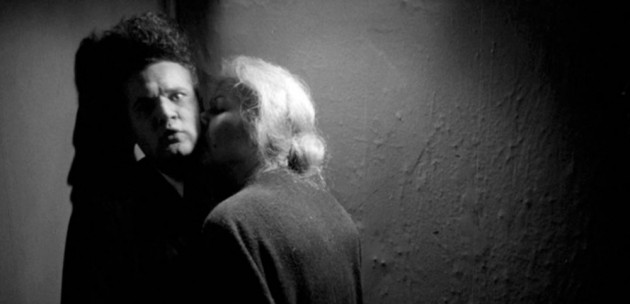
Eraserhead (Photo source, Criterion)
Henry had wanted to find out what made the baby tick, but it is this action that causes his offspring to stop ticking. Perhaps this explains why Lynch is so reluctant to answer questions about this particular creation. It’s too close to the well-spring that is the source of his ideas, and to reveal any more than he already has would do potentially irreversible damage to his own creative ecosystem. The explosion of various substances from the baby that greets Henry’s intrusion into its complicated inner world is almost enough to propel the film into the realm of body horror, a sub-category of the horror genre that focuses on the transformation of the body through science, disease or psychic phenomenon. While there is certainly a lot to link Eraserhead to body horror, a topic that Ils Huygens explores in great detail, Lynch’s film falls outside of that sort of easy categorization because his chief interest, despite the gross-out effects, is the cerebral, not the corporeal.
All of this testifies that, despite covering many of the same themes, the dark and disturbing dream that Eraserhead presents to the audience is quite distinct from the Horror genre. This is not meant to imply that it is a pointless exercise to try view it on those terms, though. The benefit to this sort of exploration is that defining horror in terms of what is not horror helps us to become more aware of what the boundaries of that genre are. It also serves to highlight unexplored areas at the fringes of the horror film, and may ultimately inspire some filmmakers to integrate techniques that are effective in terms of creating feelings of unease and discomfort in the viewer. After all, getting people off balance makes them more susceptible to moments of pure terror.
Endnotes:
Hoberman, J. and Jonathan Rosenbaum. Extract on Eraserhead from Midnight Movies. (New York: Da Capo, 1983).
Hoberman, J. “Eraserhead” in The Village Voice Film Guide. Ed, Dennis Lim (Hoboken, NJ: John Wiley & Sons, 2007).
Hoberman, J. and Jonathan Rosenbaum. Extract on Eraserhead from Midnight Movies. (New York: Da Capo, 1983).
Huygens, Ils. “They’re not even sure it is a baby yet”… Body Horror in Eraserhead. Dark Reflections, Monstrous Reflections: Essays on the Monster in Culture. Ed. Sorcha Ni Fhlainn, 2006, 79-85.
Lynch, David. Lynch on Lynch. Ed, Chris Rodley. (London: Faber and Faber, 1997).
Rombes, Nicholas. “Blue Velvet Underground: David Lynch’s Post Punk Poetics,” from The Cinema of David Lynch: American dreams, nightmare visions (London: Wallflower Press, 2004).
Woods, Paul A. Weirdsville USA: The Obsessive World of David Lynch. (London: Plexus Publishing, 1997).
Works Cited:
Friedkin, William. The Exorcist. 1973.
Hooper, Tobe. The Texas Chain Saw Massacre. 1974.
Kubrick, Stanley. The Shining. 1980.
Lynch, David. Blue Velvet. 1986.
Lynch, David. Eraserhead. 1976. Run-times taken from Absurda DVD
Lynch, David. Twin Peaks. 1990.



